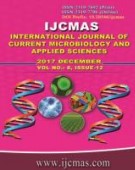


 National Academy of Agricultural Sciences (NAAS)
National Academy of Agricultural Sciences (NAAS)

|
PRINT ISSN : 2319-7692
Online ISSN : 2319-7706 Issues : 12 per year Publisher : Excellent Publishers Email : editorijcmas@gmail.com / submit@ijcmas.com Editor-in-chief: Dr.M.Prakash Index Copernicus ICV 2018: 95.39 NAAS RATING 2020: 5.38 |
The aim of present investigation was to study the inoculation effect of PGPR consortia on N supply, growth and grain yield of wheat. Results revealed the highest nitrate reductase activity with inoculation of PGPR at recommended dose of N fertilizer compared to all other treatments, indicating bioinoculant on availability of nitrogen. The highest root length was recorded in T4 (50%N+ Consortium of PGPR) which was statistically at par with T6 and T5. The root length measured for T2 (Consortium of PGPR only) (p<0.05; 14.4cm) was at par with T3 (Recommended Dose of Fertilizers). The straw yield of wheat was found significantly higher when PGPR consortia was applied along with recommended dose of inorganic fertilizers (p<0.05; 13.27g/pot) which was equal to recommended dose of chemical fertilizers (p<0.05; 13.27g/pot) and at par with T5 (p<0.05; 12.22g/pot). The grain yield of wheat was found numerically higher in T6 (p<0.05; 11.68g/pot) but was statistically at par with T3 i.e. RDF treatment (p<0.05; 10.28g/pot). Study suggested that after confirmation these isolates can be utilized as potential bioinoculants for enhancing wheat productivity.
 |
 |
 |
 |
 |